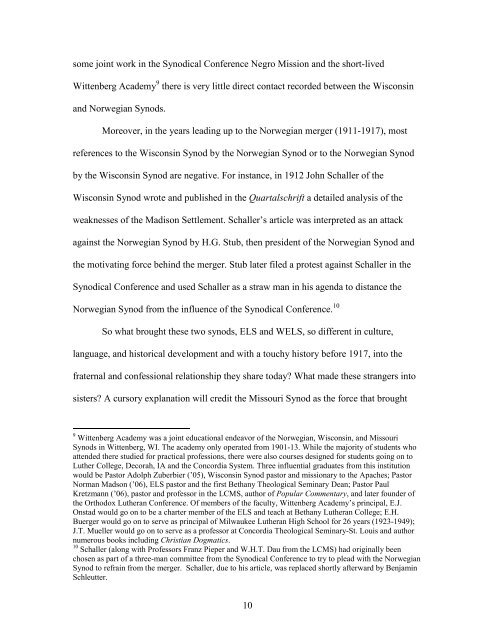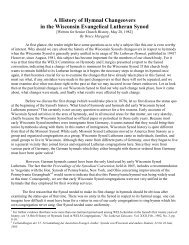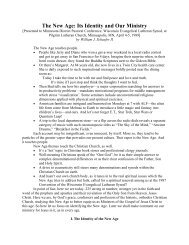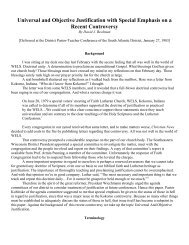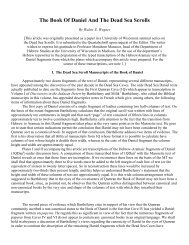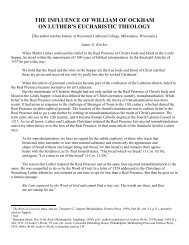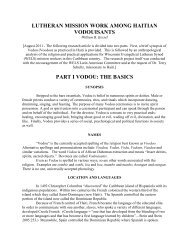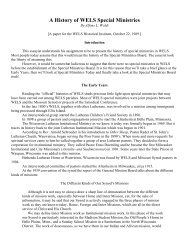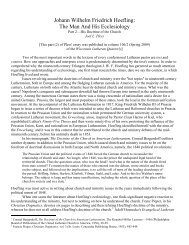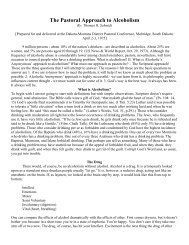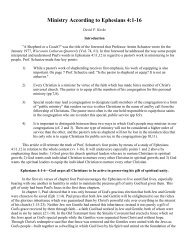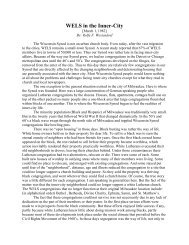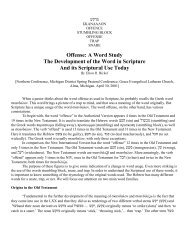Strangers to Sisters - Wisconsin Lutheran Seminary Library: Essays
Strangers to Sisters - Wisconsin Lutheran Seminary Library: Essays
Strangers to Sisters - Wisconsin Lutheran Seminary Library: Essays
You also want an ePaper? Increase the reach of your titles
YUMPU automatically turns print PDFs into web optimized ePapers that Google loves.
some joint work in the Synodical Conference Negro Mission and the short-lived<br />
Wittenberg Academy 9 there is very little direct contact recorded between the <strong>Wisconsin</strong><br />
and Norwegian Synods.<br />
Moreover, in the years leading up <strong>to</strong> the Norwegian merger (1911-1917), most<br />
references <strong>to</strong> the <strong>Wisconsin</strong> Synod by the Norwegian Synod or <strong>to</strong> the Norwegian Synod<br />
by the <strong>Wisconsin</strong> Synod are negative. For instance, in 1912 John Schaller of the<br />
<strong>Wisconsin</strong> Synod wrote and published in the Quartalschrift a detailed analysis of the<br />
weaknesses of the Madison Settlement. Schaller’s article was interpreted as an attack<br />
against the Norwegian Synod by H.G. Stub, then president of the Norwegian Synod and<br />
the motivating force behind the merger. Stub later filed a protest against Schaller in the<br />
Synodical Conference and used Schaller as a straw man in his agenda <strong>to</strong> distance the<br />
Norwegian Synod from the influence of the Synodical Conference. 10<br />
So what brought these two synods, ELS and WELS, so different in culture,<br />
language, and his<strong>to</strong>rical development and with a <strong>to</strong>uchy his<strong>to</strong>ry before 1917, in<strong>to</strong> the<br />
fraternal and confessional relationship they share <strong>to</strong>day? What made these strangers in<strong>to</strong><br />
sisters? A cursory explanation will credit the Missouri Synod as the force that brought<br />
9 Wittenberg Academy was a joint educational endeavor of the Norwegian, <strong>Wisconsin</strong>, and Missouri<br />
Synods in Wittenberg, WI. The academy only operated from 1901-13. While the majority of students who<br />
attended there studied for practical professions, there were also courses designed for students going on <strong>to</strong><br />
Luther College, Decorah, IA and the Concordia System. Three influential graduates from this institution<br />
would be Pas<strong>to</strong>r Adolph Zuberbier (’05), <strong>Wisconsin</strong> Synod pas<strong>to</strong>r and missionary <strong>to</strong> the Apaches; Pas<strong>to</strong>r<br />
Norman Madson (’06), ELS pas<strong>to</strong>r and the first Bethany Theological <strong>Seminary</strong> Dean; Pas<strong>to</strong>r Paul<br />
Kretzmann (’06), pas<strong>to</strong>r and professor in the LCMS, author of Popular Commentary, and later founder of<br />
the Orthodox <strong>Lutheran</strong> Conference. Of members of the faculty, Wittenberg Academy’s principal, E.J.<br />
Onstad would go on <strong>to</strong> be a charter member of the ELS and teach at Bethany <strong>Lutheran</strong> College; E.H.<br />
Buerger would go on <strong>to</strong> serve as principal of Milwaukee <strong>Lutheran</strong> High School for 26 years (1923-1949);<br />
J.T. Mueller would go on <strong>to</strong> serve as a professor at Concordia Theological <strong>Seminary</strong>-St. Louis and author<br />
numerous books including Christian Dogmatics.<br />
10 Schaller (along with Professors Franz Pieper and W.H.T. Dau from the LCMS) had originally been<br />
chosen as part of a three-man committee from the Synodical Conference <strong>to</strong> try <strong>to</strong> plead with the Norwegian<br />
Synod <strong>to</strong> refrain from the merger. Schaller, due <strong>to</strong> his article, was replaced shortly afterward by Benjamin<br />
Schleutter.<br />
10


